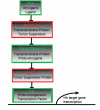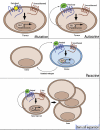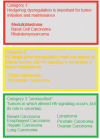Learning from Jekyll to control Hyde: Hedgehog signaling in development and cancer
- PMID: 20696410
- PMCID: PMC3651907
- DOI: 10.1016/j.molmed.2010.05.003
Learning from Jekyll to control Hyde: Hedgehog signaling in development and cancer
Abstract
The Hedgehog (Hh) cascade controls cell proliferation, differentiation and patterning of tissues during embryogenesis but is largely suppressed in the adult. The Hh pathway can become reactivated in cancer. Here, we assimilate data from recent studies to understand how and when the Hh pathway is turned on to aid the neoplastic process. Hh signaling is now known to have a role in established tumors, enabling categorization of tumors based on the role Hh signaling plays in their growth. This categorization has relevance for prognosis and targeted therapeutics. In the first category, abnormal Hh signaling initiates the tumor. In the second category, Hh signaling helps maintain the tumor. In the third category, Hh signaling is implicated but its role is not yet defined.
Copyright 2010. Published by Elsevier Ltd.
Figures




Similar articles
-
New insight into hedgehog signaling in hematological malignancies.Leuk Lymphoma. 2015 Apr;56(4):858-65. doi: 10.3109/10428194.2014.938328. Epub 2014 Aug 18. Leuk Lymphoma. 2015. PMID: 24991722 Review.
-
Aberrant activation of the hedgehog signaling pathway in malignant hematological neoplasms.Am J Pathol. 2012 Jan;180(1):2-11. doi: 10.1016/j.ajpath.2011.09.009. Epub 2011 Nov 1. Am J Pathol. 2012. PMID: 22056910 Free PMC article. Review.
-
Hedgehog signaling pathway as a therapeutic target in various types of cancer.Cancer Sci. 2011 Oct;102(10):1756-60. doi: 10.1111/j.1349-7006.2011.02010.x. Epub 2011 Jul 26. Cancer Sci. 2011. PMID: 21679342 Review.
-
Hedgehog signaling in development and cancer.Dev Cell. 2008 Dec;15(6):801-12. doi: 10.1016/j.devcel.2008.11.010. Dev Cell. 2008. PMID: 19081070 Free PMC article. Review.
-
Modulators of the hedgehog signaling pathway.Bioorg Med Chem. 2010 Sep 15;18(18):6613-24. doi: 10.1016/j.bmc.2010.07.038. Epub 2010 Jul 23. Bioorg Med Chem. 2010. PMID: 20708941 Review.
Cited by
-
Oxysterols are allosteric activators of the oncoprotein Smoothened.Nat Chem Biol. 2012 Jan 8;8(2):211-20. doi: 10.1038/nchembio.765. Nat Chem Biol. 2012. PMID: 22231273 Free PMC article.
-
Therapeutic Status and Available Strategies in Pancreatic Ductal Adenocarcinoma.Biomedicines. 2021 Feb 11;9(2):178. doi: 10.3390/biomedicines9020178. Biomedicines. 2021. PMID: 33670230 Free PMC article. Review.
-
Characterization of Hedgehog Acyltransferase Inhibitors Identifies a Small Molecule Probe for Hedgehog Signaling by Cancer Cells.ACS Chem Biol. 2016 Dec 16;11(12):3256-3262. doi: 10.1021/acschembio.6b00896. Epub 2016 Oct 25. ACS Chem Biol. 2016. PMID: 27779865 Free PMC article.
-
Hedgehog/GLI signaling in tumor immunity - new therapeutic opportunities and clinical implications.Cell Commun Signal. 2019 Dec 26;17(1):172. doi: 10.1186/s12964-019-0459-7. Cell Commun Signal. 2019. PMID: 31878932 Free PMC article. Review.
-
Radiation Sensitization of Basal Cell and Head and Neck Squamous Cell Carcinoma by the Hedgehog Pathway Inhibitor Vismodegib.Int J Mol Sci. 2018 Aug 23;19(9):2485. doi: 10.3390/ijms19092485. Int J Mol Sci. 2018. PMID: 30142876 Free PMC article.
References
-
- Nusslein-Volhard C, Wieschaus E. Mutations affecting segment number and polarity in Drosophila. Nature. 1980;287(5785):795–801. - PubMed
-
- Cohen MM., Jr. The hedgehog signaling network. Am J Med Genet A. 2003;123A(1):5–28. - PubMed
-
- Hooper JE, Scott MP. Communicating with Hedgehogs. Nat Rev Mol Cell Biol. 2005;6(4):306–17. - PubMed
-
- Rubin LL, de Sauvage FJ. Targeting the Hedgehog pathway in cancer. Nat Rev Drug Discov. 2006;5(12):1026–33. - PubMed
-
- Gailani MR, et al. The role of the human homologue of Drosophila patched in sporadic basal cell carcinomas. Nat Genet. 1996;14(1):78–81. - PubMed
Publication types
MeSH terms
Substances
Grants and funding
LinkOut - more resources
Full Text Sources
Other Literature Sources

